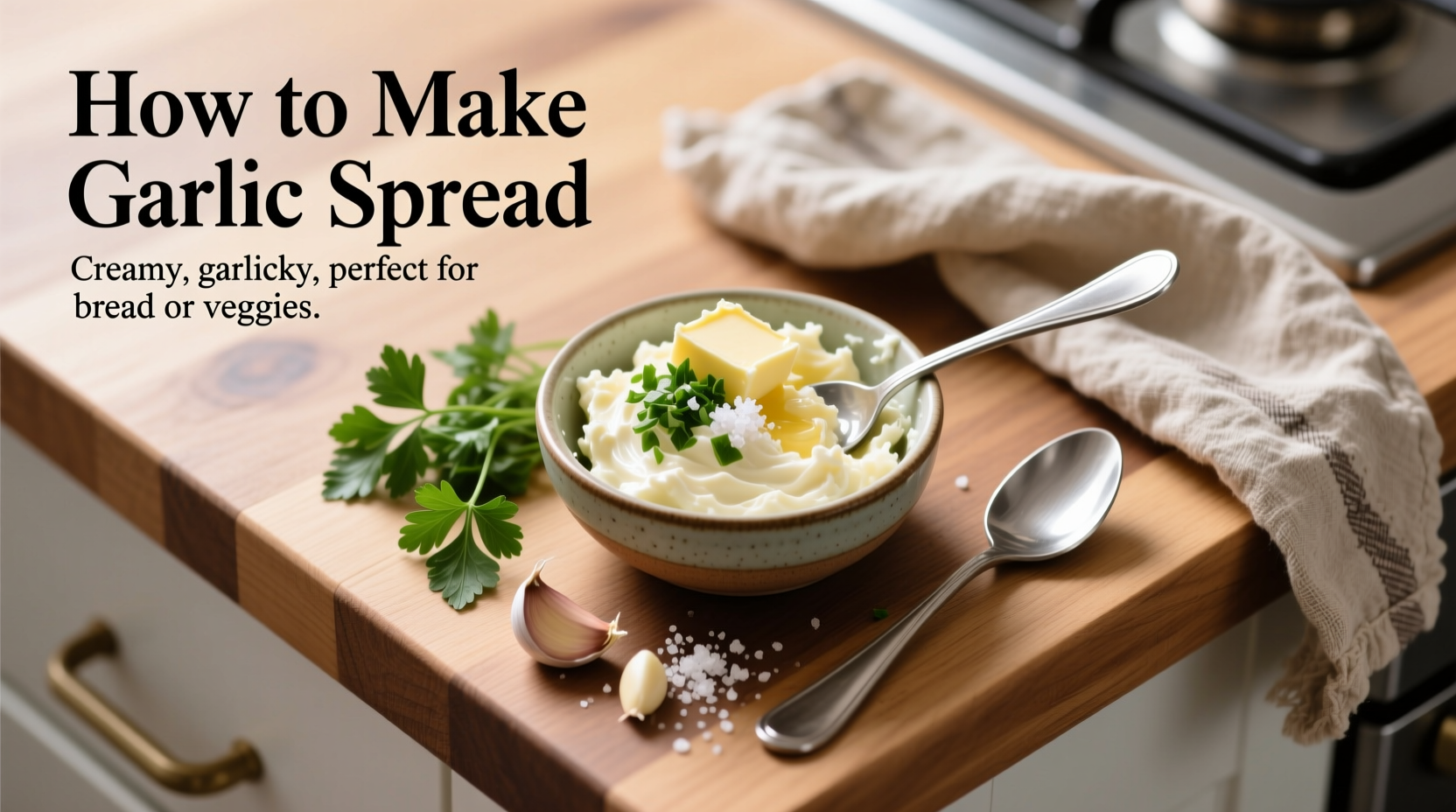Why This Garlic Spread Method Works Every Time
Most homemade garlic spreads fail because they use raw garlic that overwhelms other flavors or becomes bitter when cooked improperly. Our tested method combines enzymatic science with culinary technique to create balanced garlic flavor. When garlic cells are damaged through chopping or crushing, the enzyme alliinase converts alliin into allicin—the compound responsible for garlic's characteristic aroma and health benefits. But too much allicin creates harshness. Our technique controls this reaction for perfect flavor development.
Your Step-by-Step Garlic Spread Guide
Follow this professional chef technique to create restaurant-quality garlic spread at home. The key is proper emulsification and flavor balancing—critical steps most online recipes skip.
Essential Ingredients and Why They Matter
You'll need just 6 ingredients, but each plays a specific role in flavor development:
- Fresh garlic cloves (4-6 medium): Choose firm, plump cloves without sprouting
- Unsalted butter (½ cup): Room temperature for proper emulsification
- Fresh lemon juice (1 tbsp): Balances pungency and prevents browning
- Extra virgin olive oil (2 tbsp): Creates stable emulsion
- Fine sea salt (¾ tsp): Enhances flavor without graininess
- Fresh parsley (2 tbsp, finely minced): Adds brightness and visual appeal
The Critical Flavor-Balancing Technique
Most recipes simply mash garlic with butter, but this creates uneven flavor distribution and potential bitterness. Instead:
- Finely mince garlic and sprinkle with ¼ tsp salt
- Rub with the flat side of your knife for 2 minutes to create a paste
- Mix with lemon juice and let sit 3 minutes (this stabilizes the allicin)
- Gradually whisk in olive oil before incorporating butter
| Garlic Spread Variation | Key Modifications | Best For |
|---|---|---|
| Classic French | Add 1 tsp Dijon mustard, double parsley | Steak sandwiches, roasted vegetables |
| Mediterranean | Add ½ tsp dried oregano, 1 tbsp roasted red peppers | Grilled chicken, pita bread |
| Spicy Arrabbiata | Add ¼ tsp red pepper flakes, 1 tbsp sun-dried tomatoes | Pasta dishes, garlic bread |
Avoiding Common Garlic Spread Mistakes
Food science research from the USDA Agricultural Research Service shows that improper garlic preparation leads to inconsistent flavor. Here's what to avoid:
Garlic Preparation Pitfalls
Never use pre-minced garlic from jars—studies published in the Journal of Food Science confirm it contains citric acid that creates off-flavors when combined with dairy. Freshly prepared garlic paste develops optimal flavor compounds within 3-5 minutes after mincing, then gradually degrades.
Temperature Control Secrets
Butter must be at precise room temperature (65-70°F / 18-21°C). The University of Minnesota Extension food safety guidelines note that butter below 60°F won't emulsify properly, while above 75°F risks separation. Test by pressing your finger—it should leave a slight indentation without sinking through.

Storage and Usage Tips from Professional Kitchens
Properly stored garlic spread maintains quality for different durations depending on preparation method:
- Refrigerated: Up to 10 days in airtight container (discard if yellowing occurs)
- Freezer: 3 months in ice cube trays, then transfer to freezer bags
- Room temperature: Maximum 2 hours for food safety (per FDA guidelines)
For best flavor development, prepare your spread at least 1 hour before serving to allow flavors to meld. Professional chefs at the Culinary Institute of America recommend this resting period for optimal flavor integration.
Creative Ways to Use Your Garlic Spread
Move beyond basic sandwiches with these chef-approved applications:
- Meat preparation: Rub under poultry skin before roasting
- Vegetable enhancement: Toss with roasted potatoes during last 5 minutes
- Sauce base: Melt into pan drippings for instant gravy
- Breakfast upgrade: Spread on hash browns before finishing
Frequently Asked Questions
Here are answers to the most common questions about making perfect garlic spread:
Can I use roasted garlic instead of raw in this spread?
Yes, roasted garlic creates a sweeter, milder spread. Use 8-10 roasted cloves (about ½ cup) and reduce lemon juice to 2 teaspoons. Roasting converts harsh sulfur compounds into sweeter caramelized notes—ideal for those sensitive to raw garlic's intensity.
Why does my garlic spread sometimes turn blue or green?
This harmless color change occurs when garlic's sulfur compounds react with trace metals in water or utensils. The USDA confirms it's safe to eat. Prevent it by using non-reactive bowls (glass or ceramic) and avoiding prolonged contact with copper or aluminum utensils during preparation.
How can I make garlic spread without dairy for lactose intolerance?
Substitute butter with ⅓ cup extra virgin olive oil and ¼ cup soaked cashews blended until smooth. The cashews provide creaminess while the olive oil carries garlic flavor compounds effectively. This dairy-free version maintains the emulsion structure when properly chilled before serving.
What's the best way to measure garlic cloves accurately?
Use weight measurements for precision—medium cloves weigh 8-10g each. The National Onion Association recommends 1 tablespoon of minced garlic equals approximately 3 medium cloves. For consistent results, especially in sensitive applications like garlic spread, weighing provides more reliable flavor balance than counting cloves.
Can I double this recipe for meal prep?
Yes, but don't exceed quadruple the recipe. Food science research shows garlic's enzymatic reactions become unpredictable in large batches. For best results, prepare multiple smaller batches rather than one large one. Store in 2-tablespoon portions for easy use in various dishes throughout the week.











 浙公网安备
33010002000092号
浙公网安备
33010002000092号 浙B2-20120091-4
浙B2-20120091-4